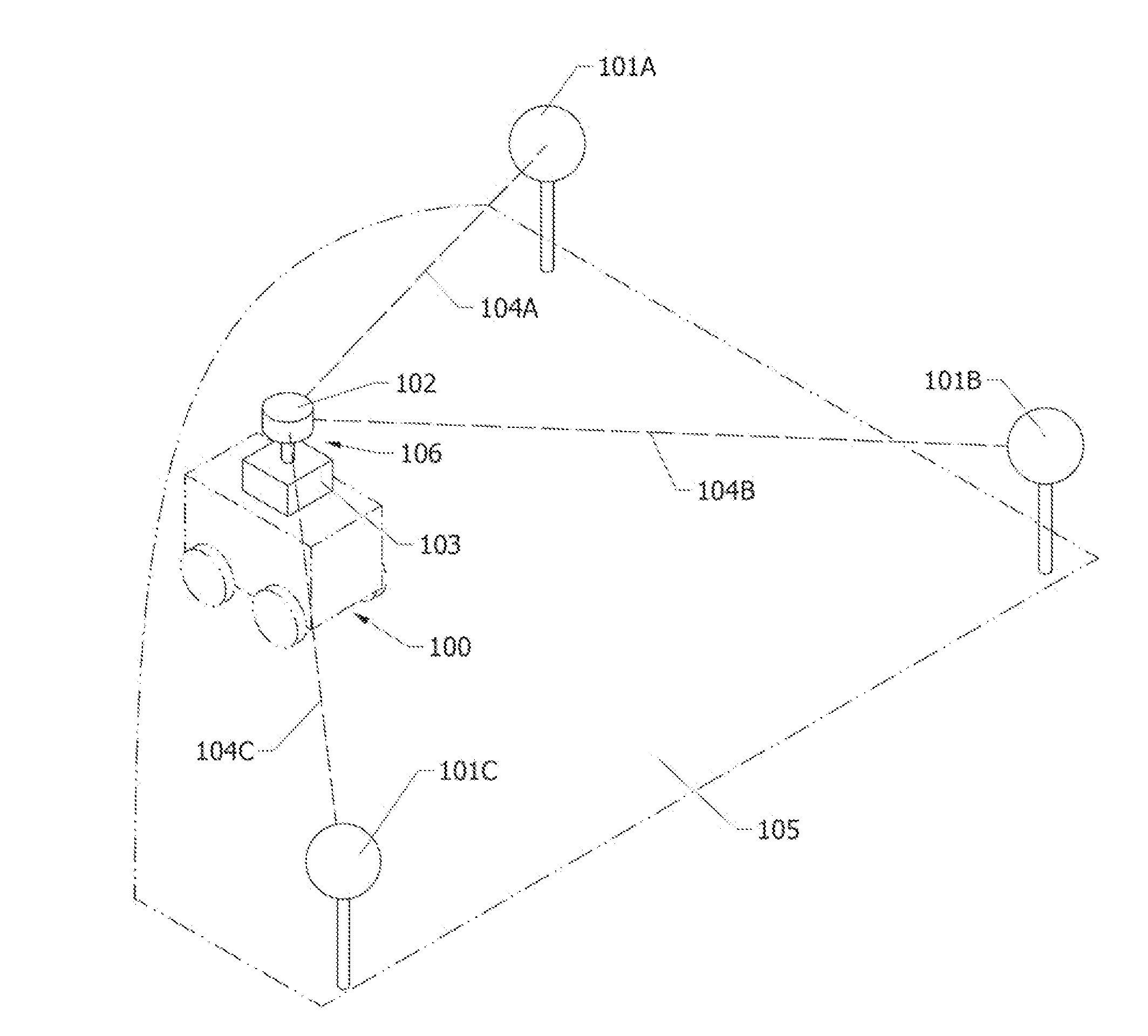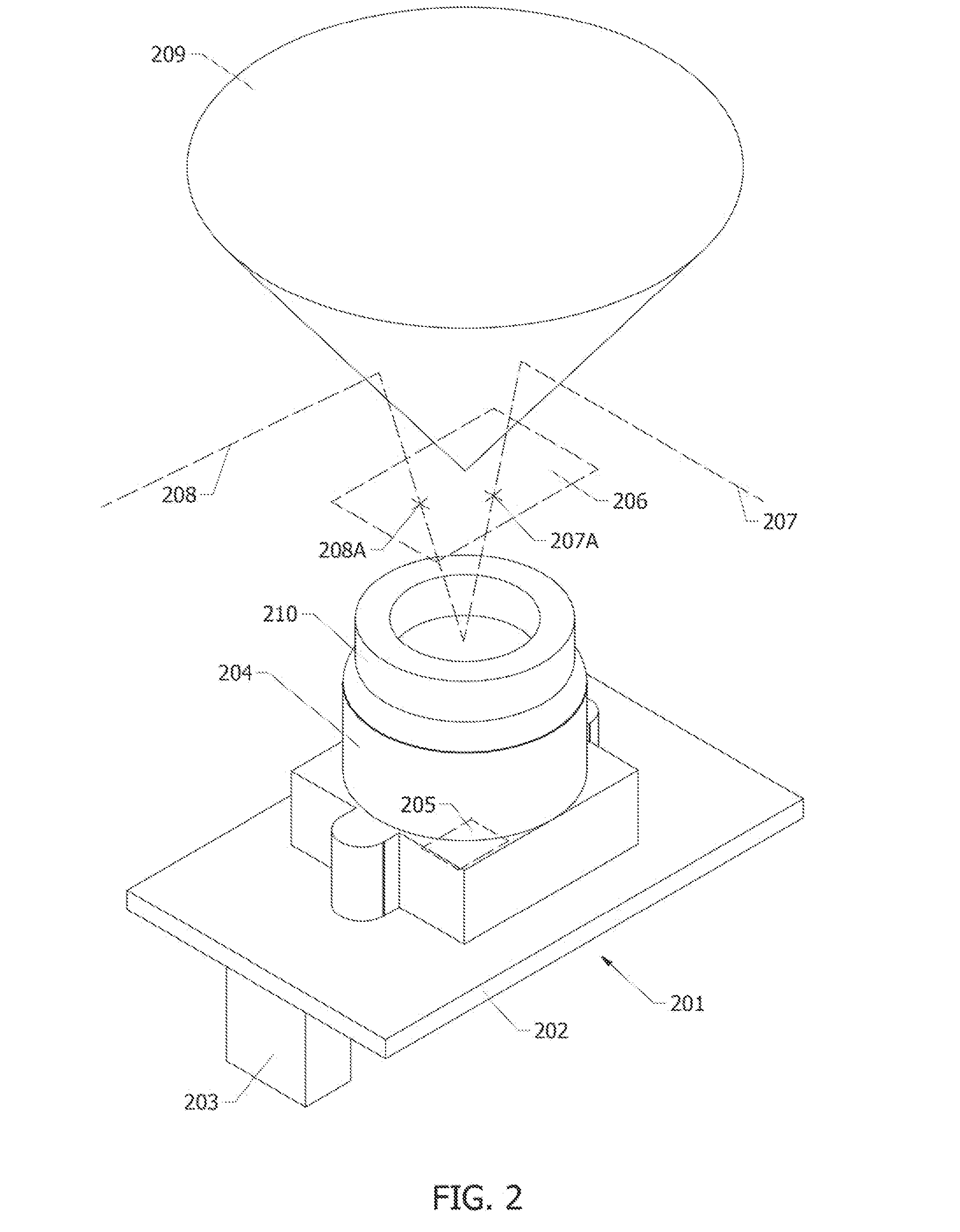System and Method for Estimating the Position and Orientation of an Object using Optical Beacons
a technology of optical beacons and positioning devices, applied in the field of system and method for estimating the position and orientation of objects using optical beacons, can solve the problems of inconvenient positioning, large working area, and difficulty in recognizing markers from different orientations and ambient lighting conditions, so as to increase the accuracy of position measurements and identify beacons quickly on demand
- Summary
- Abstract
- Description
- Claims
- Application Information
AI Technical Summary
Benefits of technology
Problems solved by technology
Method used
Image
Examples
first embodiment
FIGS. 1, 4, 5A, 5B, 5A through 5F, and 7—First Embodiment
[0042]The first embodiment improves upon the foundation b providing as robust design and method for both detecting and identifying beacons. The image sensor(s) within the imaging system 102 are of a type that allows random pixel access. The random pixel access feature allows individual pixels or small groups of pixels to be sampled at a rate that is significantly higher than the full-frame rate of the camera. For example, a typical image sensor with this capability may have a 60 hertz frame rate, but allow small groups of pixels to be sampled at 400 hertz or more. Sampling a small portion of the image sensor is often called windowing or region of interest mode, Henceforth, the frequency that full images (i.e. all pixels) are sampled will he referred to as the full-frame rate and the frequency that a small group of pixels are sampled will be referred to as the partial-frame rate. The partial-frame rate is at least twice the ful...
second embodiment
FIGS. 8, 9, and 10—Second Embodiment
[0061]The second embodiment improves upon the foundation by allowing the beacons to he distributed within the working area without interfering with processes that occur within the working area. This is achieved by burying beacons underground and providing a means for them to rise above ground when needed, as well as a means of communication with the beacons.
[0062]FIGS. 8A, 8AS, 8B, and 8BS show a particular design for a beacon that can raise itself above ground on command. FIGS. 8A and 8AS show a perspective view and a section view, respectively, of the beacon in a lowered position. In the lowered position, the top of the beacon is flush with the ground. FIGS. 8B and 8BS show a perspective view and a section view, respectively, of the beacon in a raised position.
[0063]The beacon is raised and lowered by means of as linear actuator, shown in FIGS. 8AS and 8BS. The linear actuator is composed of an electric motor 805, a screw 807, a fixed tube 802, ...
third embodiment
FIGS. 1, 2, 3 and 11—Third Embodiment
[0077]The third embodiment improves upon the foundation by increasing the signal-to-noise ratio of the beacons. This is achieved by using the atmosphere to filter extraterrestrial light.
[0078]FIG. 11A shows the spectral density of light emitted by the sun, measured above the atmosphere. The x-axis represents the wavelength of light (in terms of micrometers) and the y-axis represents light intensity (in terms of kilowatts per meter squared, per micrometer). FIG. 11B shows the spectral density of light emitted by the sun, measured at sea level. The axes of 11B are the same as FIG. 11A.
[0079]As can be seen from FIGS. 11A and 11B, the light intensity at sea level is generally lower across the spectrum, as compared to the light intensity above the atmosphere. The light intensity is especially low at and around wavelengths of 0.76, 0.94, 1.13, and 1.38 micrometers (indicated by reference, numerals 21, 22, 23, and 24, respectively). These are water and ...
PUM
 Login to View More
Login to View More Abstract
Description
Claims
Application Information
 Login to View More
Login to View More - R&D
- Intellectual Property
- Life Sciences
- Materials
- Tech Scout
- Unparalleled Data Quality
- Higher Quality Content
- 60% Fewer Hallucinations
Browse by: Latest US Patents, China's latest patents, Technical Efficacy Thesaurus, Application Domain, Technology Topic, Popular Technical Reports.
© 2025 PatSnap. All rights reserved.Legal|Privacy policy|Modern Slavery Act Transparency Statement|Sitemap|About US| Contact US: help@patsnap.com



